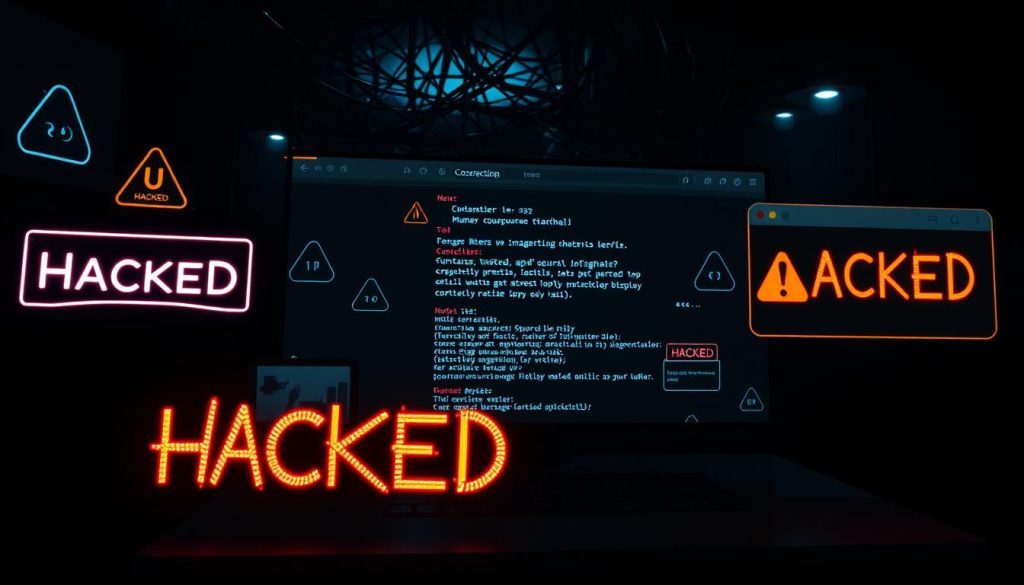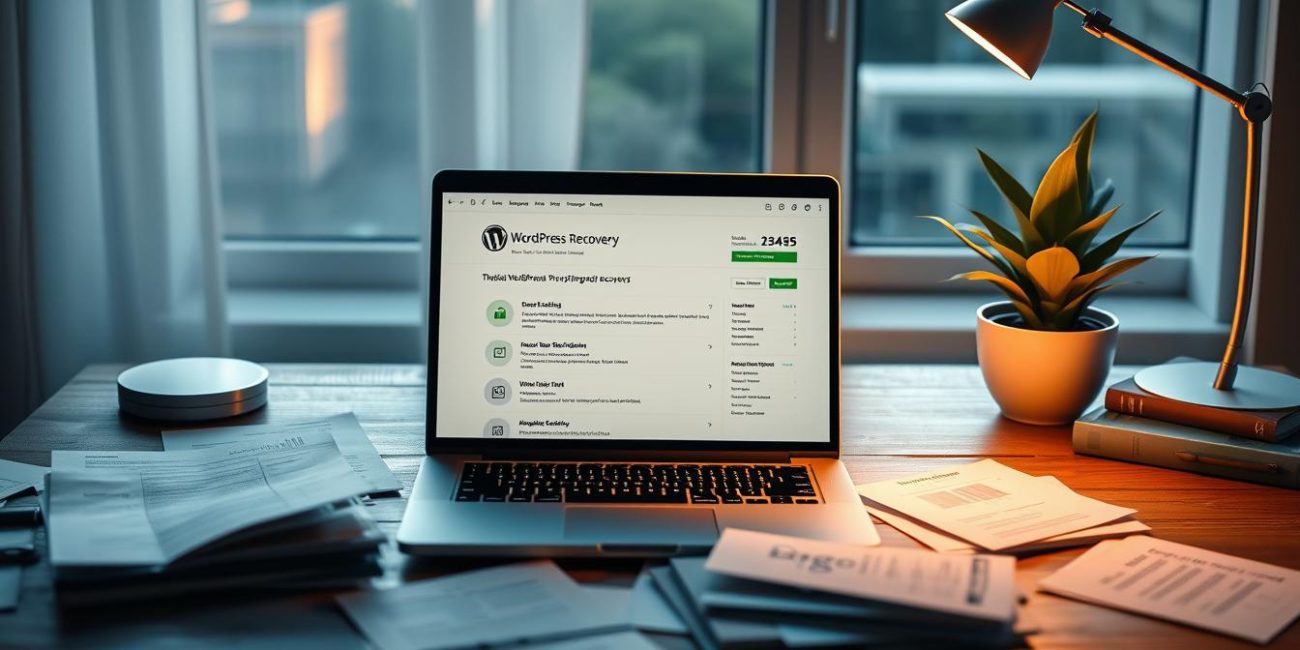Did you know that every day, more than 60,000 WordPress websites are affected? This serves to highlight how important it is to know to how to promptly recover a WordPress-hacked website. After a hack, recovering your WordPress website may seem challenging. Did you know over 60,000 WordPress websites get hacked every day? This shows how crucial it is to know how to recover your wordpress hacked website fast.
You can restore control and defend your website, though, if users take the required actions. In this guide, I’ll show you how to recover your wordpress website and shield it from future hacks.Getting your WordPress site back after a hack can seem tough. But, with the right steps, you can take back control and keep your site safe. In this guide, I’ll show you how to recover your wordpress website and shield it from future hacks.
By understanding the wordpress website recovery guide, you can fix your site quickly and well.
Signs Your WordPress Website Has Been Hacked
Finding out if your WordPress site has been hacked can be tough. But, there are clear signs to watch for. Knowing these signs is key to quickly fixing your site.
Common Visual Indicators of a Compromised Site
Visual changes are often the first signs of a hack. Look out for unfamiliar content or links and altered layouts. Even defaced pages are a warning sign. If your site looks different without reason, it’s a problem.

Behind-the-Scenes Signs of a Security Breach
Not every hack is immediately apparent. More subdued indicators could include odd login behavior or an unexpected server resource usage. Keep an eye on your website’s features and login history. Unexpected changes could be detrimental.Not all hacks show up right away. Sometimes, the signs are more hidden, like unusual server resource usage or strange login activity. Keep an eye on your site’s performance and login history. Unexpected changes can mean trouble.
When you find out your WordPress site is hacked, the first few minutes are critical. The actions you take immediately can significantly impact the extent of the damage and the ease of recovery. It’s essential to have a clear plan to protect your website and data.To fix a hacked site, first find the breach. Watch for both visible and hidden signs. This way, you can stop the damage early. Also, make sure to use strong website security measures to avoid future hacks.
Immediate Actions to Take When You Discover the Hack
It’s critical to act quickly after learning that your WordPress website has been compromised. What you do right away can make a big difference in how much damage is done and how easy it is to get back on your feet. Protecting the data and content on your website necessitates having a well-defined strategy. When you find out your WordPress site is hacked, the first few minutes are critical. The actions you take immediately can significantly impact the extent of the damage and the ease of recovery. It’s essential to have a clear plan to protect your website and data.
Isolating Your Website to Prevent Further Damage
To prevent further damage, your first step should be to isolate your website. You must put your website into maintenance mode to prevent hackers from gaining access and causing additional damage. Using a security plugin with a “maintenance mode” or manually updating your site’s architecture to restrict access is one way to accomplish this.To prevent further damage, isolating your website should be your first step. This involves putting your site into maintenance mode to stop the hacker’s access and prevent them from causing more harm. You can achieve this by using a security plugin that offers a ‘maintenance mode’ or by manually editing your site’s configuration to restrict access.
Documenting the Hack for Future Reference
Documenting the hack is crucial for future reference and for potentially involving law enforcement or your web hosting provider. Take screenshots of defaced pages, log any error messages, and note the date and time you discovered the hack. This information can be invaluable in diagnosing the issue and preventing future hacks.
Notifying Necessary Parties About the Breach
Notifying the necessary parties about the breach is a critical step. This includes your web hosting provider, as they may be able to assist in mitigating the issue. If customer data has been compromised, you may also need to notify your customers and possibly the relevant authorities, depending on your jurisdiction’s data breach laws.
| Action | Purpose | Tools/Resources |
|---|---|---|
| Isolate Website | Prevent further damage | Security plugins, maintenance mode |
| Document the Hack | Future reference, potential investigations | Screenshots, error logs, notes |
| Notify Necessary Parties | Compliance, assistance | Web hosting provider, customers, authorities |
By taking these immediate actions, you can minimize the damage caused by the hack and set the stage for a more effective recovery process. Remember, protecting your website from hacking is an ongoing effort that requires vigilance and the right tools, such as effective malware removal for WordPress site capabilities.
How to Recover Your WordPress Hacked Website in 2025
Getting your WordPress site back after a hack needs a detailed plan. It’s a bit complex, but with a clear plan, you can fix your site and make it safer.
Using Website Backups to Restore Your Site
The first thing to do is to use a backup to get your site back. This is easy if you have a recent backup. Regular backups are key to quickly fixing your site if it gets hacked. You’ll need to get into your site’s files and database, usually through a hosting control panel or FTP client.
When you’re restoring from a backup, make sure it’s clean and before the hack. A compromised backup can make your site sick again. If you use a security plugin like Wordfence or MalCare, check if it has backup and restore tools.
Scanning and Removing Malicious Code
After getting your site back from a backup, or if you don’t have one, scan for bad code and remove it. You’ll need to use wordpress security plugins that find and remove malware.
Using Security Plugins for Malware Detection
Plugins like Wordfence, MalCare, and Sucuri have great tools for finding and removing malware. They can spot and clean infected files and help keep your site safe. Here’s what you can do:
- Scan your site for malware
- Identify and remove malicious code
- Update your security plugins and WordPress core
Manual Inspection of Core WordPress Files
Sometimes, you need to check your WordPress files by hand to find and remove malware. This means comparing your files to a clean version of WordPress to find any differences. It’s a bit tricky but can catch hidden malware.
Rebuilding Critical Website Elements
In really bad hacks, you might need to rebuild parts of your site. This could mean making new pages, uploading clean files, or reinstalling themes and plugins. Making sure everything is clean and safe is key to avoiding future hacks.
By following these steps and using wordpress security best practices, you can fix your hacked WordPress site and make it much safer. Regular backups, security plugins, and checking your site by hand are all important for a strong security plan.
Essential Security Measures to Implement Post-Recovery
To keep your WordPress website safe, you need to boost its security. After fixing a hack, it’s key to add strong security steps. This helps protect your site from future threats.
Updating All WordPress Components
Start by updating your WordPress site’s parts. This means updating the core software, themes, and plugins. Old components are a common way for hackers to get in. So, keeping everything current is very important. Updates often fix security holes that hackers could use.
Strengthening User Authentication
Improving how users log in is also very important. This makes it harder for unauthorized people to get in.
Implementing Two-Factor Authentication
Two-factor authentication (2FA) adds more security to logging in. It asks for a second verification, like a code sent to your phone. This makes it much harder for hackers to get in. Plugins like Wordfence and Two-Factor Authentication make it easy to set up 2FA.
Password Management Best Practices
Good password management is key for secure logins. Use strong, different passwords for all accounts and change them often. This stops hackers from guessing your passwords. Think about using a password manager to keep your passwords safe.
Implementing Server-Level Security Protocols
Server-level security is vital to protect your site. This includes using secure connections like HTTPS, setting up a web application firewall (WAF), and watching server logs for odd activity. A secure server is your first defense against attacks.
By taking these steps, you can make your WordPress site much safer. This helps protect it from future hacks.
- Regularly update WordPress core, themes, and plugins.
- Implement two-factor authentication.
- Use strong, unique passwords and consider a password manager.
- Configure server-level security protocols like HTTPS and WAF.
Tools and Resources for WordPress Website Protection
With new hacking methods, keeping your WordPress site safe is crucial. You need strong tools and expert advice to protect it well.
Recommended Security Plugins for 2025
Using top security plugins is key to protecting your WordPress site. Here are the best ones for 2025:
- Wordfence Security: Offers firewall, malware scanning, and login security.
- MalCare: Removes malware automatically and monitors your site.
- All In One WP Security & Firewall: Provides easy-to-use security features like firewalls and login protection.
Professional Services for WordPress Security
While plugins are vital, sometimes you need a pro’s help. Here are services to boost your site’s security:
- WordPress Security Audits: Detailed checks to find weak spots and suggest fixes.
- Managed WordPress Security Services: Experts watch your site 24/7 and act fast on threats.
- Incident Response Services: Get help quickly if your site gets hacked to fix the problem fast.
Using these tools and services can make your WordPress site much safer. It will be better protected against online threats.
Conclusion
Recovering a hacked WordPress website is just the first step; ensuring it remains secure is crucial. By following the steps outlined in this wordpress website recovery guide, you’ve taken a significant step towards protecting your online presence.
To further safeguard your site, regularly update your WordPress core, themes, and plugins. Implementing robust security measures, such as strong passwords and two-factor authentication, will significantly reduce the risk of future breaches. I recommend leveraging reputable security plugins and services to enhance your website’s defenses.
As we move into 2025, staying vigilant and proactive is key to maintaining your website’s integrity. By understanding how to recover your WordPress hacked website in 2025 and implementing these security best practices, you’ll be well-equipped to handle any potential threats and keep your website secure.






